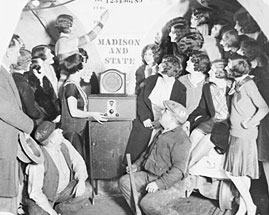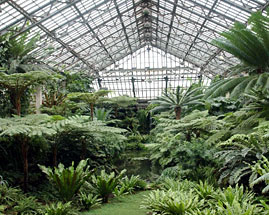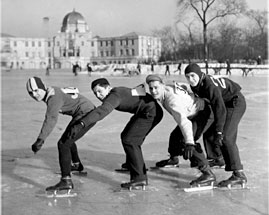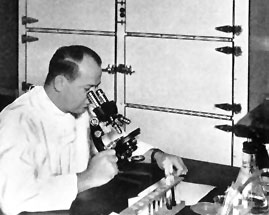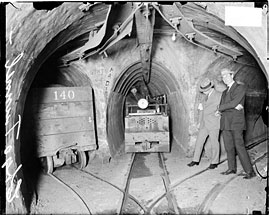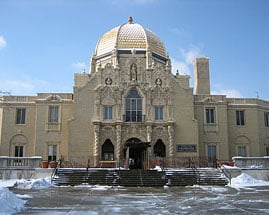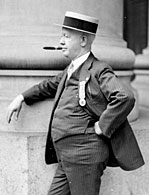
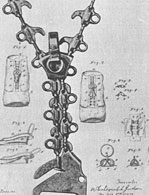
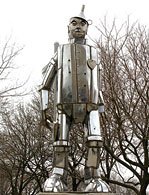
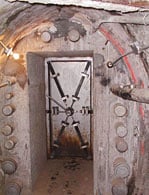

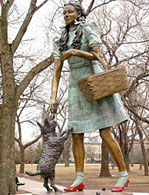
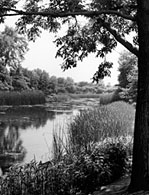

HIDDEN CHICAGO 2 with Geoffrey Baer
In this sequel to WTTW's popular Hidden Chicago special, Geoffrey Baer explores dusty attics, deep tunnels and the candy aisle at Walgreen's in search of fascinating fragments of Chicago's past and little-known stories behind things we see and use every day.
Delightfully Decadent Decoration
If you look up at the Manhattan Building on South Dearborn Street you'll be startled to see ghoulish stone faces staring back down at you! According to one story, the architect was having some fun with rubberneckers gawking at what was then Chicago's tallest building. All over Chicago you can find buildings encrusted with delightful and beautiful ornament but most of us don't stop to notice. Highlights of this story include: The stone strongman clutching lightening bolts above the door of an electrical substation in the heart of the Loop, a storage building encrusted with Egyptian ornament in Lincoln Park, and a Hyde Park bank building that's an homage to the early automobile. It was built as a parking garage in 1929 and covered with ornamental autos, wheels, engine blocks, traffic lights and more.
Chicago Utopias
Several Chicago-area neighborhoods and suburbs were built by visionaries as idealistic enclaves of religious belief, worker productivity and temperance including: Pullman, the South Side company town that revolutionized rail travel. Conceived as a workers' utopia, it became a battleground. The suburb of Zion where policemen carried bibles in their holsters instead of guns and the Spirit Fruit Society which promoted "free love" in the Chain o' Lakes.
Park District Treasures
Some of Chicago's greatest art and architecture can be found nestled in neighborhood parks all over the city. Chicago Park District historian Julia Bachrach leads Geoffrey Baer to some of the best and most surprising examples: The astonishing golden-domed administration building in Garfield Park now used as a field house (and of course the Garfield Park Conservatory, a Victorian glass palace). The magnificent prairie style Café Brauer in Lincoln Park and South Shore Cultural Center with its opulent ballroom which was once a restricted private club. Many of Chicago's major parks are also pioneering masterpieces of landscape architecture by some of the most famous names in the business, Fredrick Law Olmsted, Calvert Vaux and Jens Jensen. One of the city's newest parks is in a reclaimed limestone quarry in Bridgeport featuring rock walls and a lake. We'll also discover hidden gems like a tiny neighborhood zoo, a field house with an amazing art gallery and Chicago's smallest park, a patch of ground just a few feet across!
Hidden Neighborhoods
On the South Side is a district of tiny houses with huge front yards. They're called "Garlows," for "garage-bungalows". They were built as temporary homes to be converted to garages when owners saved enough money to build larger homes on the front of their lots. But the bigger homes were never built! Geoffrey Baer also discovers a block-long stretch of rowhouses that looks like it was transported to Chicago from London (Alta Vista Terrace), an English country village surrounded by steel mills in Northwest Indiana (East Chicago), a street of prairie-style homes designed by a disciple of Frank Lloyd Wright's in the South Side bungalow belt, a village with rural streets within the Chicago city limits (Old Edgebrook) and more.
Under Chicago
From the abandoned freight tunnels beneath the downtown Loop (they famously flooded in 1992) to Deep Tunnel (one of the greatest engineering wonders of the world) to Lower Wacker Drive, the drinking water tunnels beneath Lake Michigan, and the pumps below Buckingham Fountain, Geoffrey Baer goes subterranean to explore a whole world hidden beneath your feet in Chicago.
Palaces for the People
Chicago moguls Balaban and Katz transformed moviegoing from a mundane storefront pastime to a glamorous event in an opulent palace. And many spectacular theaters from the glory days still survive. You just have to know where to look. We explore some famous and stunningly restored palaces in the Loop like the Chicago and the Oriental. Then we head out to neighborhoods and suburbs to find former movie palaces. The world's first is a church on Chicago's west side. Its once-magnificent dome is hiding above a dropped ceiling. Some palaces have been remodeled for other uses, some are abandoned and threatened and at least one is still showing silent movies.
Made in Chicago
The Harlem Globetrotters aren't from Harlem. Tarzan isn't from Africa, the Wizard of Oz isn't from the Emerald City or even Kansas. They're all from Chicago... And so are a lot of other familiar things in your daily life: the zipper, the window envelope, Lincoln Logs and Tinker Toys, Cracker Jack, the Oscar statuette and the fireman's pole. All were invented or produced in Chicago and its suburbs! Chicago historian Tim Samuelson tells Geoffrey Baer the stories behind many Chicago-made icons of Americana.
This presentation of Hidden Chicago 2 is made possible in part by Harris Bank.
Generous support is also provided by the Joseph & Bessie Feinberg Foundation; the Walter E. Heller Foundation, in Memory of Alyce DeCosta; the A. Montgomery Ward Foundation; with additional support from the Harriet K. Burnstein & Gand family; Ken Norgan; Judy & John McCarter; and Peter Kelliher, Jr. and Diane Kelliher.
More on Chicago's Movie Palaces
- Elmhurst-based Theatre Historical Society of America
- The Uptown Theatres Facebook fan page
- Purchase the documentary "Uptown: Portrait of a Palace"
- Friends of the Uptown Theatre
- History of The Chicago Theatre
- The ultimate guide to classic movie theaters
- Lost Palaces: A Gallery of Old Movie Theatres
- The Silent Film Society of Chicago
- Chicago Area Theatre Organ Enthusiasts
